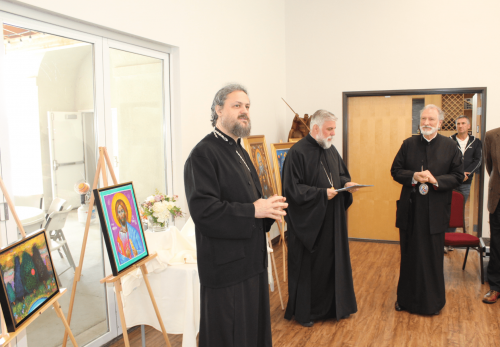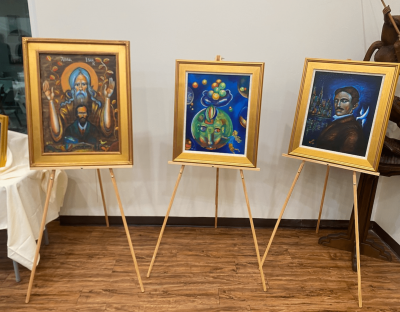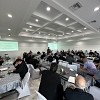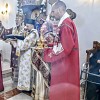After a two-year hiatus, due to the coronavirus pandemic, the Saints Sebastian and Mardarije Orthodox Institute resumed this year with its work and the 6th annual gathering was held Monday, February 20 through Wednesday, February 22, 2023. His Grace Bishop Maxim of Western America and St. George Serbian Orthodox Church in San Diego, California hosted this year’s event in collaboration with the Serbian Orthodox Institute for Faith and Culture of San Diego.
The arrival of clergy late Monday afternoon and registration was followed by Vespers served by Rev. Marko Bojovic from the St. Sava Church in Jackson, CA, and Protodeacon Dragan Stojanovich. On behalf of Bishop Maxim who was en route by plane from Chicago where he served at the funeral of the newly reposed Protopresbyter Slobodan Jovic in Libertyville, His Grace Bishop Irinej of Eastern America welcomed everyone to this year’s event, particularly this year’s speaker, His Grace Bishop Grigorije of Dusseldorf and Germany. Also in attendance were His Grace Bishop Longin of New Gracanica and Midwestern America and His Grace Bishop Mitrofan of Canada.
Following dinner, Bishop Irinej spoke about Bishop Maxim’s artwork, a sample of which was on display in the hall, which includes a number of famous Serbs. “An artist takes what’s around him and preserves it for posterity,” His Grace noted. He pointed out that in Bishop Maxim’s paintings we see a mixture of Western and Byzantine elements and further explained that “in classical Western painting one begins with the lightest values and then one shades and goes into the darkness. So then the light is superimposed from the outside on the work of art. However, when a painting is done in the Byzantine style you start with the darkest value and bring out the highlights, the lightest value. That makes the light emanate from within. Thus, the icon in the Orthodox tradition becomes its own source of light as opposed to the West where light comes from the outside.”
The Holy Hierarchical Divine Liturgy on the second day of the Institute, on the Leavetaking of the feast of the Meeting of the Lord, marked the beginning of the first full day of the Institute. Bishop Mitrofan served the Divine Liturgy. Concelebrating with His Grace were both diocesan and visiting clergy. “We invoke the prayers and blessings of the two great saints and missionaries Saints Sebastian and Mardarije, to whom this Institute is dedicated and named after. That it be blessed and profitable to all of us who take participation in it,” Bishop Mitrofan said at the conclusion of the liturgy.
In Bishop Grigorije’s introductory words to his first talk “Being with the Other” he spoke extensively and passionately about the other, our neighbor, and our misunderstanding of him as someone who is not like us, someone who is different. The theology of the other is, in fact, the theology of freedom. In not having a fear of the other we discover that without him we essentially have no existence. There are differences and then there is distance. The fact that we have differences and that we are different from one another should never cause us to distance from one another, should never lead to schism. Inasmuch as we do not desire death, the bishop said very plainly, we must accept our neighbor. Indeed, distancing ourselves from him and creating a chasm becomes for us our own experience of the fall, that is, when we have fear of the other it becomes our reminder of death. Hell, after all, is isolation from the other. There is then a danger in isolating ourselves and wanting to be separate from one another and from this danger our only salvation can be found in the other, in our neighbor.
A lively discussion ensued in which a large number of participants took part in as the topic is something close to their hearts since, living in the diaspora, there are many examples and instances of having contact and dealing with others who are different from us in many aspects.
This theme of homeland and diaspora would reappear later in the day during his second talk. In the meantime the clergy and lay participants were directed to a special presentation of the Munich Serbian Psalter. Bishop Grigorije presented a fascimile of this Psalter which is a 14th-century illuminated psalter written in the Serbian redaction of Church Slavonic, regarded as the most extensively illuminated Serbian manuscript book. It was written after 1370 in Moravian Serbia, either for its ruler Prince Lazar, or more likely, for his successor Stefan Lazarević. The book was rebound in 1630 by Serbian Patriarch Pajsije. It was taken to Bavaria in the late 17th century, and has been kept in the Bavarian State Library in Munich (as MS Cod. slav. 4) since the beginning of the 19th century.
The day’s second talk began late in the afternoon following lunch and an afternoon break. The title of the talk, “Epistle to Diognetus Today: Any country is their homeland, and any homeland is a foreign country”brought to mind this ancient Christian text in which Christians were described not as those who protested but obeyed the established laws, while at the same time their true living was in heaven. And while they lived in earthly cities, they were able to demonstrate the remarkable and admittedly unusual character of their own true citizenship. In a picturesque way the bishop spoke of his life in Germany, in a foreign land. There is a lake near the episcopal residence, and he would often go for a walk in the wooded area near the lake. This was a new city for him, a new country and, yet, after a while it occurred to him that this had become his lake, his forest. This, he continued, is something which certainly occurs to many of us living in America who, after years of living far from our homeland realize that we are at home. A most lively discussion followed the talk in which the clergy raised questions but also spoke of the challenges and their concern for the trend of what has become lawful and what not and what is accepted and what is not and what should our response be to it. Bishop Grigorije reiterated his position and point of the church being a community where the other is not rejected but accepted and it’s the church then, as a community, which will lead us on the path we need to take.
Later, during dinner, which followed Vespers, a beautiful rendition of Svilen Konac, Bach Minuet 1 and 2 and a folk kolo was performed by Cellist Popadija Biljana Bojovic which served as a most fitting end to the day’s activities.
Bishop Grigorije’s third and final talk took place the morning of the third day of the Institute and was entitled On Eccleisial Ministries and the Ministry of the Priest. The priest can very easily fall in the trap of viewing himself as being different and even better than others. Yet, the only thing in which the priest truly differs from others is that he is given much more responsibility. And what he is most responsible for is to keep the unity within the community of faithful, all of whom are given gifts of the Holy Spirit and all those gifts differ. These gifts which differ from one person to the other mustn’t ever cause us to separate one from the other. Rather, it is precisely the role of the clergy, the bishop first of all, to foster unity among the community. When the bishop stands in the midst of the church, surrounded by the clergy and the faithful only then do we make up the community we know as the church. This is why the priest never speaks on behalf of the community in the first person singular, “I”, but in the plural “we”. Otherwise, the role of the priest becomes a form of clericalism which can be extremely hazardous to the community as it creates a chasm between the people and the clergy. It allows the priest to fall in the trap of seeing himself in a way removed from the community.
The main theme of this talk, to put it succinctly, was that we are invited to create the community. This is the role of the clergy but, in reality, the role of every Christian, and every member of the community.
While the talks were in the Serbian language, a simultaneous English translation was offered to non-Serbian speaking participants by Bishop Irinej. Following a short break after the morning’s talk Bishop Irinej was asked to offer a summation of the talks. He stated that during these talks we were essentially able to refocus our attention on the core teachings of our church. Namely, the greatest accomplishment of this Institute was in the fact that we were given the opportunity to rethink that which we already know. During these two days Bishop Grigorije presented to us an Orthodox understanding of image and likeness. It’s a view of the human person from an ontological and existential perspective. The ontology of the human person is our creation as unique persons, in the image of God. However, the likeness can be akin to existentiality, that is, something which needs to be achieved. Moreover, it is the becoming, as Bishop Grigorije pointed out numerous times during the talks, the “we” unlike the “I” and “you” which is important. It is the becoming of a community and in that community, in the other, our personhood is revealed. This, from an Orthodox understanding, is the very bastion of our salvation.
The sixth annual Saints Sebastian and Mardarije Orthodox Institute concluded with the dissemination of certificates, lunch, and fellowship.
Source: westsrbdio.org
|
| |||||||||||||








